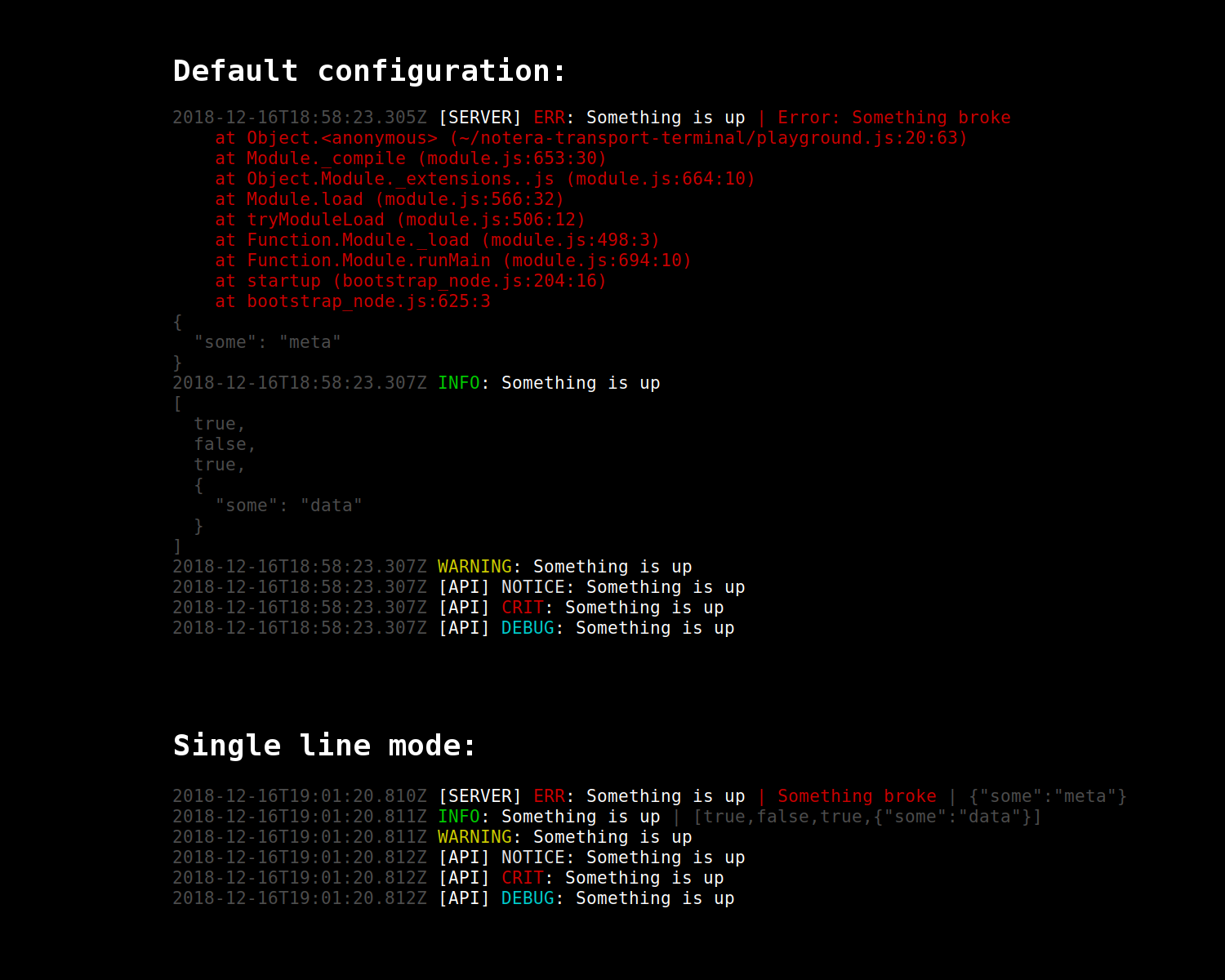README
Notera Terminal Transport
This package provides a customizable terminal transport for the Notera package. This transport atomically writes to stdout like console.log, which makes it ideal for development purposes.

Usage
Example usage with Notera:
const Notera = require('notera')
const noteraTransportTerminal = require('notera-transport-terminal')
const logger = new Notera()
logger.addTransport(noteraTransportTerminal({
// Options
}))
// Use logger as usual
logger.ctx('SERVER').info('Something is up', { some: 'meta' })
Options
Terminology
- Segment - Each logging line can be divided into segments, for example
time,ctx,msg,level,meta,err. - Entry - A logging entry generated by a call to one of the log functions in the Notera package.
interface Options {
// Disable colored/styled output. Defaults to false
disableStyle?: bool;
// Never use more than one line for one log entry. This will hide stack traces
// when logging errors, and only show the message instead. Defaults to false
singleLine?: bool;
// Colors that the default style functions use. Please refer to the "Colors"
// section for more info. Defaults to:
// emerg: red
// alert: magenta
// crit: red
// err: red
// warning: yellow
// notice: white
// info: green
// debug: cyan
colors?: [level: string]: Color;
// Configuration used when handling each segment. Please see the section
// "Configuring segments" for more information on how to configure these.
segments?: [segmentName: string]: SegmentConfig;
}
interface SegmentConfig {
// How this segment should be ordered amongst the other
index: number;
// Function to format the segment
format?: (entry: NoteraLogEntry, opts: Options) => string;
// Function to determine the color of this segment this specific log entry.
// Use a simple string (Color) if you don't need dynamic coloring.
style?: Color | (entry: NoteraLogEntry, opts: Options) => Color;
}
Configuring segments
The default print format and style like the image in the top of this readme, is accomplished with a configuration that looks like this:
{
disableStyle: false,
singleLine: false,
colors: {
emerg: 'red',
alert: 'magenta',
crit: 'red',
err: 'red',
warning: 'yellow',
notice: 'white',
info: 'green',
debug: 'cyan'
},
segment: {
time: {
index: 10,
format: _ => new Date().toISOString(),
style: 'gray'
},
ctx: {
index: 20,
format: ({ ctx }) => ` [${ctx}]`
},
level: {
index: 30,
style: ({ level }, opts) => opts.colors[level],
format: ({ level }) => ' ' + level.toUpperCase()
},
msg: {
index: 40,
format: ({ msg }) => `: ${msg}`
},
err: {
index: 50,
format: ({ err }, opts) => ` | ${opts.singleLine ? err.message : err.stack}`,
style: 'red'
},
meta: {
index: 60,
format: ({ meta }, opts) =>
` | ${JSON.stringify(meta, ...(opts.singleLine ? [] : [null, 2]))}`,
style: 'gray'
}
}
}
Changing a segment
To change segment settings, you can simply overwrite them. Note that the settings will be merged with the default settings at feature-level. See the configuration examples below.
const config = {
// ...
segment: {
ctx: {
// Turns off formatting for the 'ctx' segment. Resulting in a simple
// append from the previous segment.
format: null,
// Reset the default style of the 'ctx' segment
style: null,
// Reorder the 'ctx' segment to be placed after all other segments
index: 100
},
}
}
Adding a custom segment
You can add totally custom segment that are evaluated on every log entry. Example:
const config = {
// ...
segment: {
// Include the current memory usage in each log entry
memory: {
index: 15,
format: () => ` MEM ${Math.round(os.freemem() / 1024 / 1024)} MiB`
}
}
}
Disable a segment
To disable a segment you can set the segment config to null:
const config = {
// ...
segment: {
ctx: null
}
}
Colors
This package is using ansi-styles under the hood to colorize the terminal output. Please refer to their readme to see what colors are available.
Installation
npm install notera-transport-terminalyarn add notera-transport-terminal